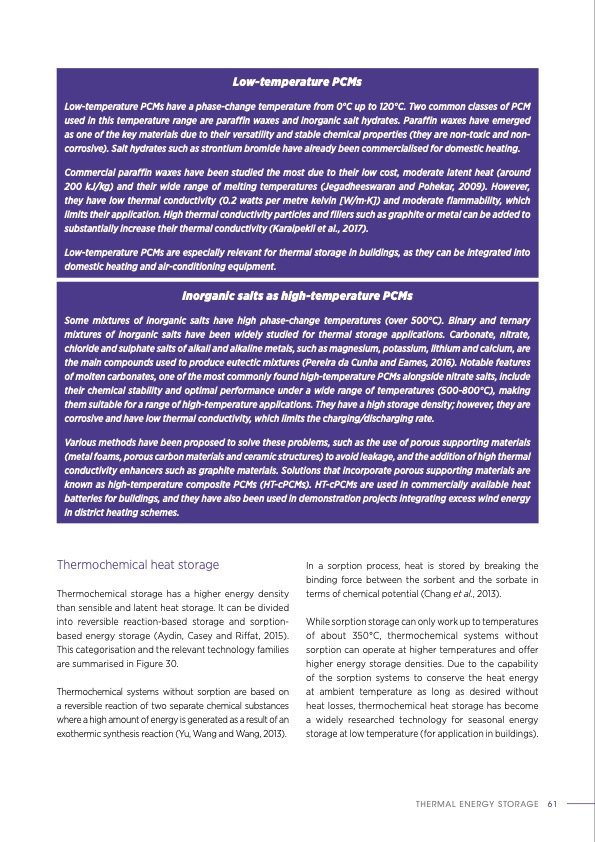
PDF Publication Title:
Text from PDF Page: 061
Low-temperature PCMs Low-temperature PCMs have a phase-change temperature from 0°C up to 120°C. Two common classes of PCM used in this temperature range are paraffin waxes and inorganic salt hydrates. Paraffin waxes have emerged as one of the key materials due to their versatility and stable chemical properties (they are non-toxic and non- corrosive). Salt hydrates such as strontium bromide have already been commercialised for domestic heating. Commercial paraffin waxes have been studied the most due to their low cost, moderate latent heat (around 200 kJ/kg) and their wide range of melting temperatures (Jegadheeswaran and Pohekar, 2009). However, they have low thermal conductivity (0.2 watts per metre kelvin [W/m·K]) and moderate flammability, which limits their application. High thermal conductivity particles and fillers such as graphite or metal can be added to substantially increase their thermal conductivity (Karaipekli et al., 2017). Low-temperature PCMs are especially relevant for thermal storage in buildings, as they can be integrated into domestic heating and air-conditioning equipment. Inorganic salts as high-temperature PCMs Some mixtures of inorganic salts have high phase-change temperatures (over 500°C). Binary and ternary mixtures of inorganic salts have been widely studied for thermal storage applications. Carbonate, nitrate, chloride and sulphate salts of alkali and alkaline metals, such as magnesium, potassium, lithium and calcium, are the main compounds used to produce eutectic mixtures (Pereira da Cunha and Eames, 2016). Notable features of molten carbonates, one of the most commonly found high-temperature PCMs alongside nitrate salts, include their chemical stability and optimal performance under a wide range of temperatures (500-800°C), making them suitable for a range of high-temperature applications. They have a high storage density; however, they are corrosive and have low thermal conductivity, which limits the charging/discharging rate. Various methods have been proposed to solve these problems, such as the use of porous supporting materials (metal foams, porous carbon materials and ceramic structures) to avoid leakage, and the addition of high thermal conductivity enhancers such as graphite materials. Solutions that incorporate porous supporting materials are known as high-temperature composite PCMs (HT-cPCMs). HT-cPCMs are used in commercially available heat batteries for buildings, and they have also been used in demonstration projects integrating excess wind energy in district heating schemes. Thermochemical heat storage Thermochemical storage has a higher energy density than sensible and latent heat storage. It can be divided into reversible reaction-based storage and sorption- based energy storage (Aydin, Casey and Riffat, 2015). This categorisation and the relevant technology families are summarised in Figure 30. Thermochemical systems without sorption are based on a reversible reaction of two separate chemical substances where a high amount of energy is generated as a result of an exothermic synthesis reaction (Yu, Wang and Wang, 2013). In a sorption process, heat is stored by breaking the binding force between the sorbent and the sorbate in terms of chemical potential (Chang et al., 2013). While sorption storage can only work up to temperatures of about 350°C, thermochemical systems without sorption can operate at higher temperatures and offer higher energy storage densities. Due to the capability of the sorption systems to conserve the heat energy at ambient temperature as long as desired without heat losses, thermochemical heat storage has become a widely researched technology for seasonal energy storage at low temperature (for application in buildings). THERMAL ENERGY STORAGE 61PDF Image | THERMAL ENERGY STORAGE Outlook

PDF Search Title:
THERMAL ENERGY STORAGE OutlookOriginal File Name Searched:
IRENA_Innovation_Outlook_TES_2020.pdfDIY PDF Search: Google It | Yahoo | Bing
Turbine and System Plans CAD CAM: Special for this month, any plans are $10,000 for complete Cad/Cam blueprints. License is for one build. Try before you buy a production license. More Info
Waste Heat Power Technology: Organic Rankine Cycle uses waste heat to make electricity, shaft horsepower and cooling. More Info
All Turbine and System Products: Infinity Turbine ORD systems, turbine generator sets, build plans and more to use your waste heat from 30C to 100C. More Info
CO2 Phase Change Demonstrator: CO2 goes supercritical at 30 C. This is a experimental platform which you can use to demonstrate phase change with low heat. Includes integration area for small CO2 turbine, static generator, and more. This can also be used for a GTL Gas to Liquids experimental platform. More Info
Introducing the Infinity Turbine Products Infinity Turbine develops and builds systems for making power from waste heat. It also is working on innovative strategies for storing, making, and deploying energy. More Info
Need Strategy? Use our Consulting and analyst services Infinity Turbine LLC is pleased to announce its consulting and analyst services. We have worked in the renewable energy industry as a researcher, developing sales and markets, along with may inventions and innovations. More Info
Made in USA with Global Energy Millennial Web Engine These pages were made with the Global Energy Web PDF Engine using Filemaker (Claris) software.
Sand Battery Sand and Paraffin for TES Thermo Energy Storage More Info
| CONTACT TEL: 608-238-6001 Email: greg@infinityturbine.com | RSS | AMP |